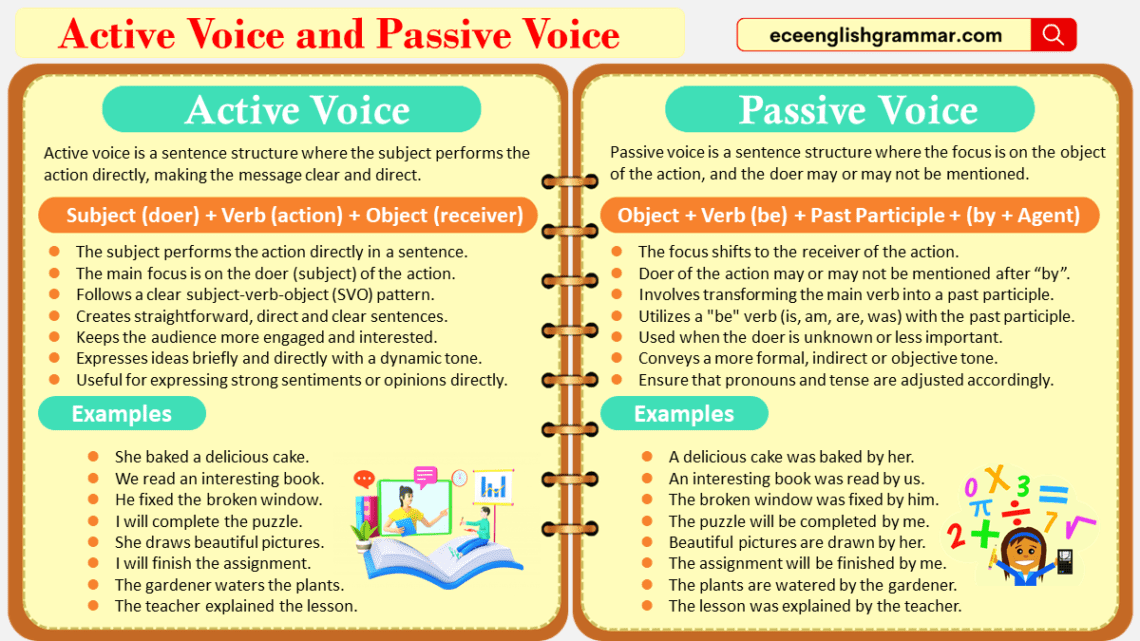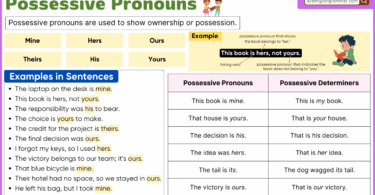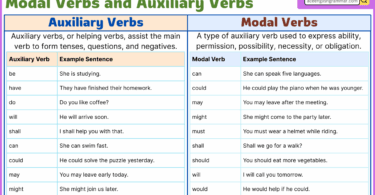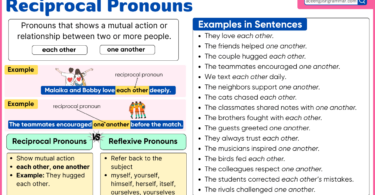In English grammar, the voice of a sentence refers to whether the subject performs the action or receives the action. The two main voices are active voice and passive voice. These are the two different ways of expressing actions or relationships between the subject, verb, and object in a sentence. Active voice is a more direct and clear way of expressing an action, while passive voice is used when the focus is on the object or receiver of the action rather than the doer. Understanding the difference between active and passive voice is crucial for clear and effective communication in both spoken and written English. So, Let’s explore the basics of active and passive voice with various examples.
Table of Contents
What is Passive Voice?
Active voice is a way of forming sentences where the doer of the action is clear and takes center stage. In simpler terms, it’s like saying who or what is doing something. In active voice, you have three main parts: the one doing the action (subject), the action itself (verb), and the one receiving the action (object). Here the subject comes first in the sentence, followed by the action (verb), and then the object that receives the action. For example, “The teacher (subject) explains (verb) the lesson (object).” Here, it’s clear that the teacher is doing the action of explaining. Active voice is often used in everyday communication because it sounds more direct, engaging, and easy to understand.
Structure of Active Voice
The structure of an active voice sentence follows a clear and direct pattern, often known as SVO. In this structure:
- Subject (doer) + Verb (action) + Object (receiver)
- Example: She (subject) eats (verb) an apple (object).
Examples:
What is Passive Voice?
Passive voice is a way of constructing sentences where the focus is on what happened to something or someone, rather than who did it. In passive voice, the action takes center stage, and the receiver of the action becomes the subject of the sentence. Instead of saying who is doing the action, we highlight what or who is affected by the action. The focus shifts from the doer to the receiver of the action. For example, in the sentence “The cake was baked,” the focus is on the cake and the fact that it got baked, without mentioning who did the baking. Passive voice is often used when we don’t know or don’t need to say who performed the action, or when the action is more important than the doer.
Structure of Passive Voice
The structure of a passive voice sentence differs from that of an active voice sentence. In a passive construction, the focus shifts from the doer of the action to the receiver or the object of the action. The structure of a passive voice sentence is as follows:
- Object + Verb (be) + Past Participle + (by + Agent (optional))
- Example: An apple (object) is eaten (verb) by her (agent).
Verb (be): (is, are, am, was, were, being, been) Agent: (doer of the action)
Examples:
- The cake was baked by my sister.
- The story was told by the teacher.
- The message was sent by email.
- The letter was written by my friend.
- The house was painted last summer.
Rules for forming a passive voice
- Identify the subject, verb, and object in the active sentence.
- Move the object of the active sentence to the beginning of the passive sentence. in other words (The places of subject and object are interchanged).
- Transform the main verb into its past participle form.
- Combine the past participle with a form of the auxiliary verb “to be” (is, am, are, was, were, has been, have been).
- The pronoun representing the subject changes based on the subject’s role in the sentence.
- Ensure that pronouns and tense are adjusted accordingly.
| Active Voice (Subject) | Passive Voice (Object) |
| I | me |
| You | you |
| He/She/It | him/her/it |
| We | us |
| They | them |
Optionally, if the doer of the action (agent) is mentioned, it is introduced with “by” if necessary.
Difference Between Active And Passive Voice
| Active Voice | Passive Voice |
| Subject + Verb + Object | Object + Verb (be) + Past Participle + (by + Agent) |
| the subject comes before the verb in the sentence | the object comes before the verb in the sentence |
| emphasizes the doer of the action | emphasizes the receiver |
| May not emphasize the receiver of the action. | Can be indirect and less straightforward. |
| makes your writing more engaging and dynamic | makes sentences wordy and less engaging |
| makes sentences often clearer and more direct and preferred in most writing situations | useful in specific contexts, such as when the doer is unknown, or unimportant, or when the focus is on the recipient of the action rather than the doer |
Formation of active and passive voice in different tenses.
The tense of the sentence does not affect whether you can use active or passive voice; both voices can be used with any tense. However, the structure of the sentence will vary depending on the tense. Let’s go through some common tenses and how they are used in both active and passive voices:
| Tense | Active Voice | Passive Voice |
| Simple Present | Subject + Verb (base form) + Object | Object + is/am/are + V3 + (by + Subject) |
| Simple Past | Subject + Verb (past tense) + Object | Object + was/were + V3 + (by + Subject) |
| Simple Future | Subject + will + Verb (base form) + Object | Object + will be + V3 + (by + Subject) |
| Present Continuous | Subject + is/are + Verb (-ing) + Object | Object + is/are being + V3 + (by + Subject) |
| Past Continuous | Subject + was/were + Verb (-ing) + Object | Object + was/were being + V3 + (by + Subject) |
| Present Perfect | Subject + has/have + Verb (past participle) + Object | Object + has/have been + V3 + (by + Subject) |
| Past Perfect | Subject + had + Verb (past participle) + Object | Object + had been + V3 + (by + Subject) |
| Future Perfect | Subject + will have + Verb (past participle) + Object | Object + will have been + V3 + (by + Subject) |
Simple Present Active And Passive Voice Examples Sentences
| Active voice | Passive voice |
| Sarah reads a book. | A book is read by Sarah. |
| He solves the puzzle quickly. | The puzzle is solved quickly by him. |
| He opens the door. | The door is opened by him. |
| The teacher explains the topic. | The topic is explained by the teacher. |
| We water the plants regularly. | The plants are watered regularly by us. |
Present Continuous Examples Sentences
| Active voice | Passive voice |
| I am writing a letter. | A letter is being written by me. |
| He is cooking dinner. | Dinner is being cooked by him. |
| They are painting the wall. | The wall is being painted by them. |
| We are planting flowers. | Flowers are being planted by us. |
| He is drawing a picture. | A picture is being drawn by him. |
Present Perfect Examples Sentences
| Active voice | Passive voice |
| He has written a book. | A book has been written by him. |
| We have visited the zoo. | The zoo has been visited by us. |
| They have cooked dinner. | Dinner has been cooked by them. |
| She has completed the project. | The project has been completed by her. |
| The team has won the game. | The game has been won by the team. |
Simple Past Examples Sentences
| Active voice | Passive voice |
| She wrote a story. | A story was written by her. |
| They caught the thief. | The thief was caught by them. |
| The waiter served the food. | The food was served by the waiter. |
| Sana washed the dishes. | The dishes were washed by Sana. |
| The doctor gave him medicine. | He was given medicine by the doctor. |
Past Continuous Examples Sentences
| Active voice | Passive voice |
| I was writing an email. | An email was being written by me. |
| He was fixing the bicycle. | The bicycle was being fixed. |
| She was reading a novel. | A novel was being read. |
| They were studying for the test. | The test was being studied for. |
| We were waiting for the bus. | The bus was being waited for. |
Past Perfect Examples Sentences
| Active voice | Passive voice |
| They had visited the museum. | The museum had been visited. |
| She had written a book. | A book had been written by her. |
| She had sung a lovely song. | A lovely song had been sung by her. |
| They had built a house. | A house had been built by them. |
| They had caught a big fish. | A big fish had been caught by them. |
Simple Future Examples Sentences
| Active voice | Passive voice |
| She will draw a beautiful picture. | A beautiful picture will be drawn by her. |
| I will call you later. | You will be called by me later. |
| They will build a new house. | A new house will be built by them. |
| They will buy new phone. | New phone will be bought by them. |
| I will clean my room. | My room will be cleaned by me. |
Future Perfect Examples Sentences
| Active voice | Passive voice |
| I will have written the letter. | The letter will have been written by me. |
| He will have painted the picture. | The picture will have been painted by him. |
| We will have finished the project. | The project will have been finished by us. |
| They will have built the house. | The house will have been built by them. |
| She will have baked the cake. | The cake will have been baked by her. |
Note;
Not all sentences can be converted into passive voice.
- Present perfect continuous tense
- Past perfect continuous tense
- Future continuous tense
- Future perfect continuous tense
Also, the sentences having intransitive verbs.
Only sentences with a transitive verb (a verb that requires an object) can be converted
Active and Passive Voice Example Sentences
| Active Voice | Passive Voice |
| He hit the ball. | The ball was hit by him. |
| She sings a beautiful song. | A beautiful song is sung by her. |
| They built a new house. | A new house was built by them. |
| she eats an apple. | An apple is eaten by her. |
| The teacher praised the students. | The students were praised by the teacher. |
| We will finish the project on time. | The project will be finished on time. |
| We are watching the movie. | The movie is being watched by us. |
| The storm destroyed the old barn. | The old barn was destroyed by the storm. |
| She made a delicious cake. | A delicious cake was made by her. |
| She delivered the letters. | The letters were delivered. |
| He wrote an interesting story. | An interesting story was written by him. |
| They are playing football. | Football is being played by them. |
FAQs
Q1: What is active voice?
Active voice is a sentence construction where the subject performs the action directly. It is characterized by a clear and straightforward structure, emphasizing the doer of the action.
Q2: What is passive voice?
Passive voice is a sentence construction where the focus shifts from the doer of the action to the receiver or object of the action. It often involves transforming the main verb into a past participle and using a form of the auxiliary verb “to be.”
Q3: When should I use active voice?
Active voice is generally used when you want to convey a direct and clear message, placing emphasis on the doer of the action. It is often preferred for its immediacy and simplicity.
Q4: When should I use passive voice?
Passive voice is used when the focus is on the object or receiver of the action rather than the doer. It is suitable for situations where the doer is unknown, less important, or when a more formal tone is desired.
Q5. How can I convert active-voice to passive-voice?
To convert active voice to passive voice, move the object to the beginning of the sentence, use the appropriate form of “to be,” and add the past participle form of the verb. Optionally, include the original subject with “by” to show who performed the action.
Q6. Give example sentences of active and passive voice.
Here are some example sentences of active and passive voice:
- The sun melts the ice. (Active)
- The ice is melted by the sun. (Passive)
- He fixed the broken toy. (Active)
- The broken toy was fixed by him. (Passive)
- She baked a delicious cake. (Active)
- A delicious cake was baked by her. (Passive)





Leave a Comment